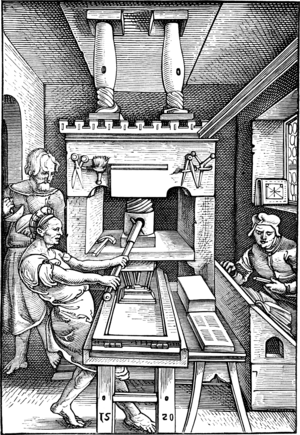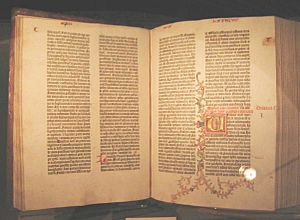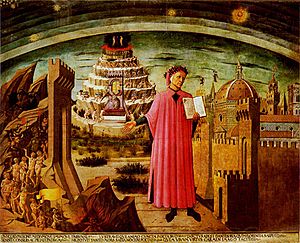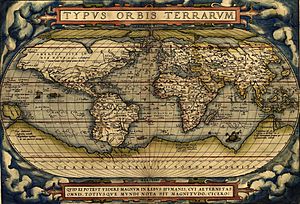Renaissance facts for kids
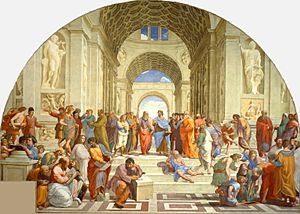
The Renaissance was a special time in European history. It started around the year 1400, right after the Middle Ages.
The word 'Renaissance' means 'rebirth' in French. People called it this because they rediscovered old ideas and knowledge from Ancient Greece and Ancient Rome. It was like a 'rebirth' of learning and art. Many people see the Renaissance as the beginning of the 'modern age'.
During this time, many famous artists, writers, and thinkers appeared. People also studied mathematics and different sciences a lot more. Someone who is good at many different things is sometimes called a "Renaissance man". Leonardo da Vinci is a great example. He was a painter, a scientist, a musician, and a philosopher!
The Renaissance began in Italy and then spread across all of Europe. In Italy, this period is often divided into three parts:
- Early Renaissance
- High Renaissance
- Late Renaissance
After the Renaissance came the Baroque period, which started around 1600. Outside Italy, it can be tricky to tell exactly where the Renaissance ends and the Baroque period begins.
Contents
What Caused the Renaissance?
In the Middle Ages, most books were made by hand in monasteries, churches, and universities. These books were called manuscripts. Some had beautiful hand-drawn and colored pictures, known as illuminated manuscripts.
Most books were written in Latin, Greek, or Roman languages, used by the Catholic Church. Only priests and very educated people could read Latin. It was even against the law to translate the Bible into everyday languages like Italian or English.
The Printing Press Changes Everything
Around 1440, the first printed books appeared in Europe. Printing quickly got better, making it possible to print large books like the Bible cheaply. It took many animal skins (like calf or pig) to make just one Bible!
Printers then started printing all sorts of interesting things:
- Old Greek and Roman writings
- poetry and plays
- Lives of saints
- mathematics and medical textbooks
- Christian stories
- Books about animals and monsters
- advice for rulers
- maps of the world
Before the printing press, only priests, monasteries, and universities held most of the knowledge. Suddenly, thousands of people, even merchants, could learn much more than ever before!
Discovering Ancient Roman Ruins
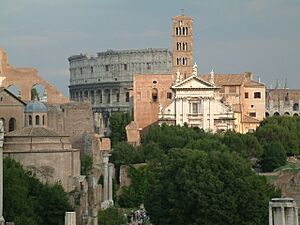
People in the Renaissance looked back at Ancient Greece and Ancient Rome as a "Golden Age". They saw it as a time when things were beautiful, well-organized, and well-run. This golden time lasted from about 400 BC to 400 AD.
By 1400, in the city of Rome, people would walk among the ruins of a once-great city. Inside the broken walls, which had been damaged in 410 AD, were the remains of huge temples, sports arenas, public baths, apartment buildings, and palaces. Most were ruined and half-buried. Many were even pulled down to use their stone for new buildings. But these ruins showed people what amazing things could be built.
In 1402, a young man named Filippo Brunelleschi and a teenager named Donatello arrived in Rome. They were amazed by everything. They measured old ruined buildings, drew pictures, and dug for weeks looking for broken statues and pottery pieces to put back together. They were like the world's first archaeologists! When they returned home to Florence, they knew more about Ancient Roman architecture and sculpture than anyone had in about a thousand years. Brunelleschi became a very famous architect, and Donatello became a very famous sculptor.
Money and Power in Italy
The city of Florence is often where people say the Renaissance truly began. Back then, Italy was not one single country. It was made up of many small states, each with its own way of governing. They were always fighting or making allies with each other.
Rome was powerful because it was home to the Pope, the leader of the Roman Catholic Church. Because of his great spiritual importance, most people and cities didn't want to argue with the Pope. Since a new pope was chosen when the old one died, rich and powerful families always hoped one of their own might be elected. It was a good idea to have young men in the family become priests, just in case. It was also smart to be friends with other rich families. One way to do this was by arranging marriages between their daughters and powerful men from different cities. This is how politics worked back then.
Other powerful cities included:
- Venice, known for its large navy.
- Milan, which controlled trade with Northern Europe and was very rich.
- Genoa, which controlled trade with France and Spain and was also very rich.
- Florence, the birthplace of the Renaissance.
Florence's power didn't come from a strong army or a good fortress. It came from banking. The clever business skills of one family, the Medici, were very important in making Florence powerful and a center for Renaissance learning.
Key Moments of the Renaissance
Art and Creativity
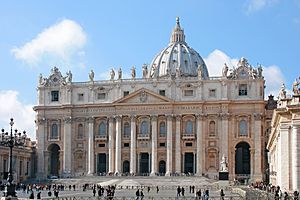
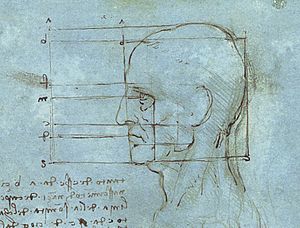
- 1401: Lorenzo Ghiberti wins a competition to create the famous Baptistry Doors in Florence.
- 1420s: Masaccio and Masolino paint the Brancacci Chapel in Florence, showing new ways of painting.
- 1440s: Donatello creates the impressive statue of Gattamelata on Horseback in Padua.
- 1470s: Botticelli paints Birth of Venus in Florence, a very famous artwork.
- 1490s: Leonardo da Vinci paints The Last Supper and the Mona Lisa in Milan.
- 1508-1512: Michelangelo paints the amazing Sistine Chapel Ceiling in Rome.
Building and Architecture
- 1420: Building begins on The Dome of Florence Cathedral, designed by Brunelleschi.
- 1420s: Brunelleschi designs the church of Church of San Lorenzo in Florence.
- 1444: Michelozzo designs the Medici-Riccardi Palace for Cosimo de' Medici.
- 1471: Alberti designs the Church of Sant' Andrea in Mantua.
- 1506: Work starts on the new St. Peter's Basilica in Rome.
- 1550: Palladio designs the Villa Rotunda near Vicenza.
Science and New Inventions
- Early 1300s: The first guns appear.
- 1423: The first printed books are made in Europe.
- Late 1400s: The quadrant is developed, helping sailors navigate at sea.
- 1480s: Leonardo da Vinci deeply studies human anatomy.
- 1550s: watches are made by Peter Henlein of Nuremberg.
- 1608: The first Telescope is created by Hans Lipershey in Holland.
- 1618: William Harvey explains that blood is pumped by the heart.
New Ways of Thinking
(See illustration above: Raphael's "School of Athens")
- Early 1300s: Petrarch publishes writings based on ancient and early Christian thinkers.
- Mid 1400s: The Humanist Academy begins, a place to discuss old writings and new ideas, supported by the Medici family.
- 1511: Desiderius Erasmus publishes In Praise of Folly, which pointed out that many church leaders were not living holy lives.
- 1532: The Prince by Machiavelli is published. It explains how people seeking political power often do tricky things to get it.
Changes in Religion
- 1382: The Bible is first translated from Latin into English by John Wycliffe. This started a movement to translate it into many European languages.
- 1454-1455: Johann Gutenberg prints his famous Bible.
- 1517: Martin Luther posts The Ninety-Five Theses (ideas for discussion about church problems) on a church door. This was a key event in the Reformation.
- 1534: Henry VIII separates the Church of England from the Roman Catholic Church.
- 1545: Pope Paul III calls the Council of Trent. This meeting of Catholic leaders discussed how to respond to the Reformation, starting the Counter Reformation.
- 1559: John Calvin starts the Geneva Theological Academy to teach new (Reformation) ideas about Christian faith.
Famous Writings
- Early 1300s: Dante Alighieri writes The Divine Comedy in Italy.
- 1348: Giovanni Boccaccio starts writing The Decameron, a collection of stories from Italy.
- 1477: William Caxton publishes Geoffrey Chaucer's Canterbury Tales, an important early English book written in the 1300s.
- 1532 and 1534: Francois Rabelais writes Pantagruel and Gargantua in France.
- 1550: Giorgio Vasari publishes "Lives of the Great Architects, Painters and Sculptors of Italy".
- 1590-1612: William Shakespeare writes his 37 plays in England.
- 1605 and 1616: Miguel de Cervantes publishes Don Quixotte, Man of la Mancha in Spain.
World Exploration
- 1487-1488: Bartholomeu Dias sails down the coast of Africa to the Cape of Good Hope.
- 1492: Christopher Columbus sails from Spain across the Atlantic Ocean to the West Indies.
- 1497-1499: Vasco da Gama sails from Portugal, around Africa, to Calicut in India.
- 1519-1522: Ferdinand Magellan leads an expedition to sail around the world. It is completed by Juan Sabastian del Cano.
- 1577-1580: Sir Francis Drake completes the second voyage around the world.
Related Pages
Images for kids
-
Florence, where the European Renaissance began. New ideas in architectural perspective, modern systems, and fields of banking and accounting started here.
-
Portrait of a Young Woman (c. 1480–85) (Simonetta Vespucci) by Sandro Botticelli
-
View of Florence, the birthplace of the Renaissance.
-
Coluccio Salutati, an important early Renaissance scholar.
-
Lorenzo de' Medici, a powerful ruler of Florence and a great supporter of the arts (Portrait by Vasari).
-
Giovanni Pico della Mirandola, who wrote the famous Oration on the Dignity of Man, sometimes called the "Manifesto of the Renaissance".
-
An old portrait of Nicolaus Copernicus (c. 1580), who proposed that the Earth orbits the Sun.
-
Portrait of Luca Pacioli, known as the "father of accounting", painted by Jacopo de' Barbari, 1495.
-
Alexander VI, a Borgia Pope.
-
Leonardo Bruni, a Renaissance historian.
-
"What a piece of work is a man, how noble in reason, how infinite in faculties, in form and moving how express and admirable, in action how like an angel, in apprehension how like a god!" – from William Shakespeare's Hamlet.
-
Château de Chambord (1519–1547), a famous example of Renaissance architecture in France.
-
Portrait of Emperor Maximilian I, by Albrecht Dürer, 1519.
-
Erasmus of Rotterdam in 1523, painted by Hans Holbein the Younger.
-
The Royal Monastery of San Lorenzo del Escorial, designed by Juan de Herrera and Juan Bautista de Toledo.
-
A cover of the Lives of the Artists by Giorgio Vasari.
See also
 In Spanish: Renacimiento para niños
In Spanish: Renacimiento para niños


